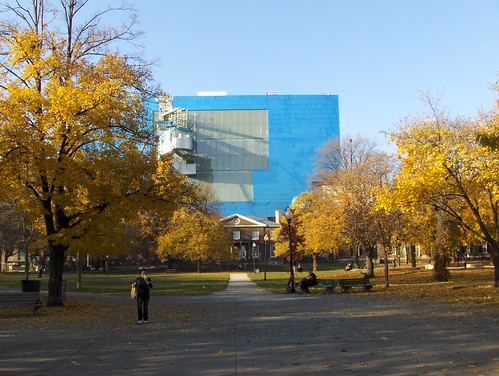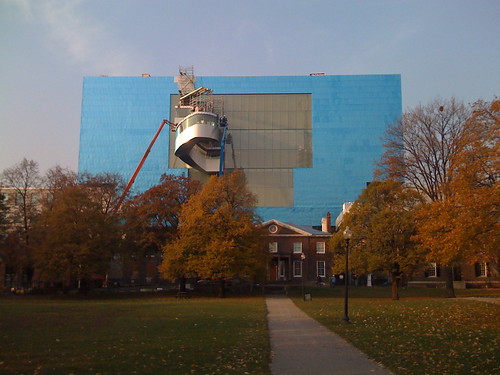
ED: For the next few weeks Spacing Associate editor Shawn Micallef will be the Blogger-in-Residence at the Art Gallery of Ontario’s Art Matters blog in anticipation of the grand re-opening of the new AGO. He will be cross-posting some of the entries here on Spacing Toronto. Keep an eye (or RSS feed) on the Art Matters blog for other posts by Shawn and other contributors.
In Toronto the presence of the AGO along Dundas has been as familiar as a family member. Always there, reliable, maybe even taken for granted. When the big fence went up around it for the Transformation project a couple years ago — and when it ultimately closed earlier this year for the final months of the renovation — the absence was suddenly the only thing we could notice when in the area. I say we because just about everytime I’ve passed by the AGO from one direction or another, there are at least a few sidewalk foremen or women watching the construction take place. Chatter about the building elsewhere — at parties, overheard in the workplace — is more and more frequent. Perhaps the upshot of being closed for a while is that anticipation builds in a way it otherwise couldn’t.
I love the view above of the new AGO from Grange Park. With the blend of new and old, there is something quintessentially Toronto in this angle. This, I believe, is the elusive “Toronto look” that we often fumble around looking for as we try to define, without success, what Toronto looks like in our mind’s eye. This city is often able to effortlessly accommodate Victorian and Edwardian structures — in this rare case even older, as The Grange house dates to 1817 and the Georgian period — next door to contemporary skyscrapers and modern buildings. Architectural and heritage purists may disagree, but a good heritage building can keep up with and match wits with a contemporary building anytime, and The Grange does this just fine.
This mix of old and new also prevents the building from becoming simply a museum piece, preserved in architectural formaldehyde as if time has not passed a minute since it was built. Inside, The Grange does all the things it should, showing us how folks lived back when the Family Compact ruled Upper Canada, but to get inside we now have to pass through one of the new contemporary art spaces that Frank Gehry’s firm has created, always reminding us that it belongs as much to us today as it did the Boulton family of the nineteenth century. Kind of like how Toronto itself works, always evolving, where the very old is mixed in with the very new — along with everything in between.

The view to the south from the AGO has always been special, with a clear view down John Street to the hump of the erstwhile Skydome. Standing here you get a sense of the power of the early aristocratic families who could lay out streets so the view from their front porch was magnificent. In our Toronto we can now climb to the upper galleries and look south to the lake, a brand new view that includes a rare vista down the middle of a street, all made possible by a planning decision made nearly 200 years ago. Conversely, looking north, the new AGO can be seen like few other buildings in Toronto can: unimpeded and from a distance. Walking north from King or Queen — especially in the winter when the leaves are off the trees — the AGO will rise in front of us, framing the Grange below with a blue titanium sky. It’s likely this will become as iconic a Toronto view as the one of Old City Hall seen when walking up Bay Street.

This week I saw two cranes working on the “Barnacle Staircase” on the back of the building. Gehry’s structures don’t look like the buildings we’re use to (though his prolific work in the last decade or two have started to change that) and the far-out alien contortions of the metal look like something from of a 1970s sci-fi film with the cranes acting as some kind of robotic machine picking at the mysterious creature. When I encounter buildings like this, I always wish I could have been a fly on the wall when the construction workers were first shown the plans. “You want us to do what with what,” I imagine they say. Or maybe not. Maybe the prospect of working on something like this is as exciting as standing outside it and looking up, waiting for it to open, anticipating when we’ll get to wander around inside ourselves.




23 comments
Shawn:
There is a nice view from afar on top of the building spacing’s offices are in.
Steve
Indeed (of OCAD too). Methinks that will be a future post.
It’s a pity the genteeleness of Grange Park has been killed off by that huge building overpowering the trees and Grange House.
I lament the end of that park’s special nature.
I have one small quibble with the reno: why not reclad the 70s stucco on the east and west sides? The fact that I can see that bothers me for some reason, and makes me think something is unfinished.
Funny about the “Barnacle Staircase” business. When I first saw it being installed, it made *me* think of…a labia.
I think I’ve been hanging around the Internet too long.
There are very few people who LIVE in the neighbourhood who like the box over the top of Grange Park — it is am imposition upon one of the most interesting buildings of its period, not to mention the fact the its future use is not focussed on heritage education.
The view down John street actually ends up in the entrance to a parking garage — so you’ll need to look more closely.
And as for Beverley Street – you’ll need to understand building in the context of what Parkin built.
No puff pieces please. I thought that Spacing was above that.
Easy, Ceta. Just because someone likes the AGO doesn’t mean its a puff piece. You decided to live near Canada’s biggest Art Gallery a few blocks from the core of the city — there are going to be a lot of pressure points. While you may not like or agree with this, but the AGO’s renovations will have a much greater impact on the city as a whole than it does to you personally. I sympathize that residents were inconvenienced during construction but when there’s no pain, there’s no gain.
No puff ceta, it’s how I’ve felt for a long time about this building.
IMO the box makes an interesting building more interesting. Why is it such an imposition? In Banff, we seem to like the mountains imposing themselves over the buildings — they are “beautiful” — why is that different if the “thing”is human made? Never understood that part of the anti-skyscraper position (though this is not a skyscraper — but same idea).
I like Parkin a lot (too much, maybe) — I like what was there before — but it was a moat. A moat I liked, but how is that moat ok and the box not? These questions are all asked with genuine interest, not snarkiness. I want to see the other side.
There is a parking garage at the end of John, and there is a bridge over to the CN Tower and Skydome too. You can’t see either until Wellington. But none of that was my point.
I love the view of the new AGO in the Grange, it complements OCAD nearby and frames the park nicely. It provides a point of interest in views up John Street. And now we have another interesting building of its period – our own! How fabulous is that?
Cities don’t sit still, they are a boiling pot of innovation and change. The Grange and the AGO are both very much of their era, and I love them both.
Maurice: You missed my point. As well, I never said that I didn’t like the AGO. You have misrepresented what I said.
Nort have I said anything about the interior of the building – the galleria is lovely; so too is walker court.
I was addressing the appropriateness of treatment of a heritage building with respect to its use and how it is dwarfed.
And further, Lisa Rochon’s comment is to this point –
“Finally, the back elevation of the gallery lords over the park in an uneasy relationship. There was an attempt to match the floating irreverence of Will Alsop’s neighbouring Ontario College of Art & Design by cladding the AGO contemporary-art tower with a wacky, though jarring, tint of blue titanium panels. But the power of the idea has been lost by gallery windows that cast a gloom over the back elevation like a dead TV screen. Still, the five-storey steel tower can be magic at night – when the colour grows subdued, the glass disappears, and the shadows of the city climb around the views.”
It works at night …
I have to admit that every time I hear people talking about heritage buildings, my mind flashes forward to the year 2060, when I totally expect Spacing Wire to host an incredibly vicious flamewar over how stupid developers want to take away our history by tearing down the electronic billboards at Dundas Square, replacing the ROM crystal with granite cladding, and converting the waterfront condominiums into skyfarms.
Unfortunately, the blue cladding looks like a Tyvek vapour barrier. Perhaps they could have used “anodised aluminium†like the ROM did.
All through the renovation I’d assumed the blue was some kind of Tyvek that would come off at the end, and am very disappointed to find out it’s staying. It looks appalling, and completely jarring. Grange Park used to have a beautiful symmetry to it that the extension above has destroyed.
I completely agree with Joe Clark’s post. This building will forever look like it’s under construction.. Other than the unfortunate tint of the titanium, though, I think it’s beautiful.
Then again, I can see “Tyvek Tower” winding up a label of affection, in spite of itself. Maybe not on a “Flatiron Building” level, but…
What an improvement. People should remember what the AGO looked like before. Grange house now looks like it is on a stage; I feel the blue wall will actually attract more attention to it just like the photo for the posting.
My hopes are high that unlike the ROM the AGO will be a great building on the outside and on the inside.
I don’t mind the blue of the box. In fact, I kind of like it and its large expanse.
What I don’t like about the tower is how it utter ignores the Grange. It does absolutely nothing to accommodate itself to its neighbour. It could have been a striking frame for the older building below it. Instead its situation and its ugly, thoughtless window placement make it an affront to the Grange. It would not have taken much thought or effort to compliment the Grange and the park rather than insult it.
My own feeling is that the blue box is too overwhelming for the Grange building and park in size, colour and shape. In a way, it’s almost too blunt for a Gehry building — some interesting curves might have complemented the Grange a lot more, but I don’t think the AGO had the budget for the full Gehry (the curved new front Gehry built is much more like what I’d want), which is a shame. I feel that the view up John Street just isn’t what it could have been, it will be jarring rather than inspiring.
It’s also a little odd that the blue box is just slightly asymmetrical with the Grange, looking like they tried to match them up and missed.
I also think that it’s out of place overlooking the park, which is what I thought about the OCAD extension too (a building I would probably like in a different context). But I will say that they work together much better than they would (did, in the case of OCAD) if only one of them was there – they kind of balance out. And the park was already undermined years ago anyway when they allowed that huge slab at the south-west end.
I’m more with ceta than with the puffery. While the new building does have good points and qualities, it is far too much for this historic building, site and context. We don’t have too many truly old buildings around.
The extra light reflection may well harm the mature trees in the park as well.
It would have been smarter to have somehow split the collection up a bit somehow to share the wealth with another part of town, but that would have involved far more politics than just a big building.
I look forward to having safe cycling north on Beverly – there was some motion passed about three years ago at the TCC about the safety issues of how the AGO and the City allocated the reduced space on Beverly south of Dundas St., but nothing happened but hazards for bikes.
I like it. Funny the one at the top who called it puff never really explained why she didn’t like it. Who is puff now? Guy above talks about extra light reflection. Ya and aliens rule ottawa. Ha, crazy. Glad these cranky ones aren’t in charge of the city.
Toronto’s Architectural Facelifts
This is tonight’s show on The Agenda with Steve Paikin on TVO. Details: http://urlzen.com/325
Have an opinion?
Get your thoughts read by Steve Paikin on air, comment at tvo.org: http://urlzen.com/30b
We are also taking live emails as well, 8-9pm. http://www.tvo.org/theagenda
If you miss the November 13 broadcast you can download the podcast or watch it online.
Expected show guests:
Lisa Rochon, Architectural Critic, Globe & Mail
Christopher Hume, Urban Affairs Columnist, Toronto Star
Rodolphe el-Khouri, University of Toronto
Anne Bordeleau, University of Waterloo
Kyle Rae, Toronto city counsellor, Ward 27
Shawn Micallef, sen.editor, Spacing magazine
Kyle Rae brought us Yonge-Dundas Square and TL Square. He is famously hostile to democratic opinion. Why is his name on this site?